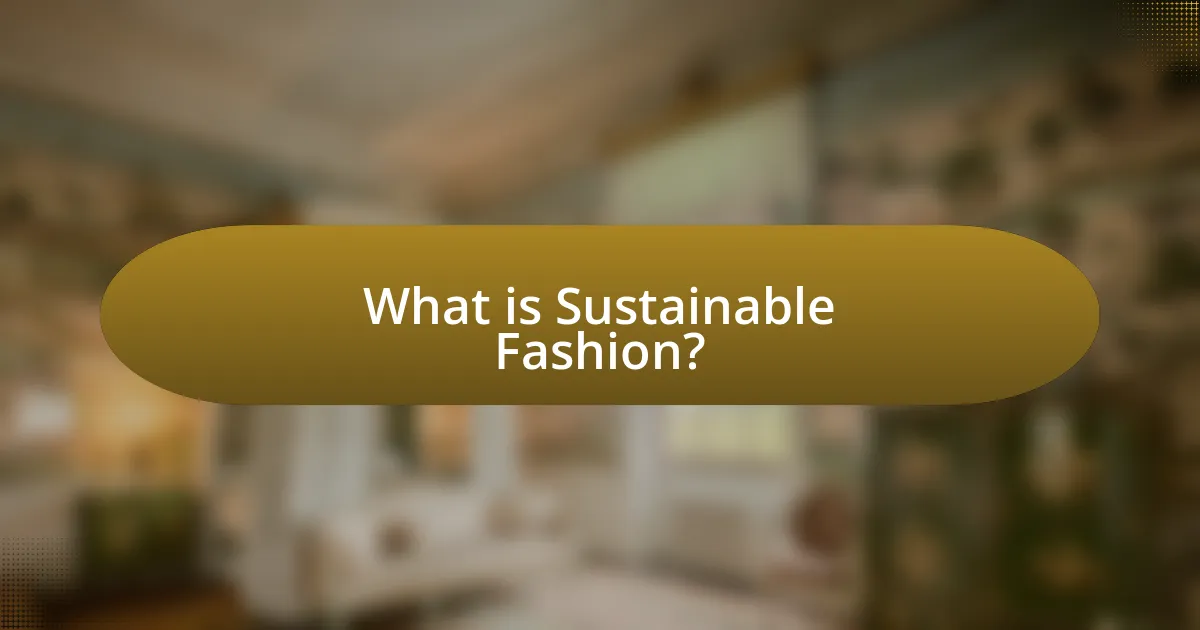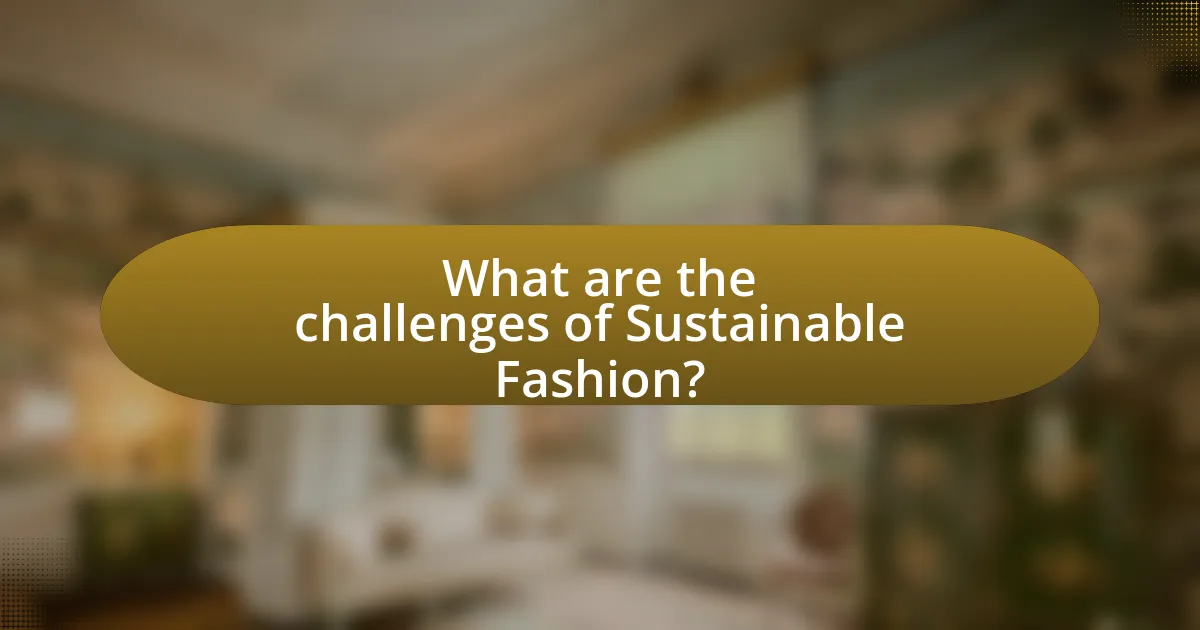Sustainable fashion refers to clothing and accessories produced with minimal environmental impact and social responsibility, emphasizing eco-friendly materials, ethical labor practices, and sustainable production methods. The article highlights the importance of sustainable fashion for environmental conservation, detailing the fashion industry’s significant contribution to carbon emissions and resource consumption. Key principles include ethical production, resource conservation, and waste reduction, while practical steps for individuals to adopt sustainable practices involve prioritizing quality, supporting ethical brands, and incorporating second-hand items into their wardrobes. Additionally, the article addresses challenges consumers face, misconceptions about sustainable fashion, and the role of technology in promoting eco-friendly practices.

What is Sustainable Fashion?
Sustainable fashion refers to clothing and accessories that are produced, consumed, and disposed of in ways that minimize environmental impact and promote social responsibility. This approach encompasses the use of eco-friendly materials, ethical labor practices, and sustainable production methods. According to the Global Fashion Agenda’s 2021 report, the fashion industry is responsible for 10% of global carbon emissions, highlighting the urgent need for sustainable practices to mitigate climate change.
Why is Sustainable Fashion important for the environment?
Sustainable fashion is important for the environment because it significantly reduces waste and pollution associated with the textile industry. The fashion industry is responsible for 10% of global carbon emissions and is the second-largest consumer of water, leading to severe environmental degradation. By utilizing eco-friendly materials, promoting ethical production practices, and encouraging recycling and upcycling, sustainable fashion minimizes the negative impact on ecosystems and conserves natural resources. For instance, organic cotton uses 91% less water than conventional cotton, demonstrating a clear environmental benefit.
How does the fashion industry impact environmental sustainability?
The fashion industry significantly impacts environmental sustainability through high resource consumption and pollution. It is responsible for approximately 10% of global carbon emissions, largely due to energy-intensive production processes and transportation. Additionally, the industry contributes to water pollution, with textile dyeing releasing toxic chemicals into waterways, affecting ecosystems and human health. The production of synthetic fibers, such as polyester, further exacerbates environmental issues by relying on fossil fuels and generating microplastics that contaminate oceans. These facts illustrate the urgent need for sustainable practices within the fashion sector to mitigate its detrimental effects on the environment.
What are the key principles of sustainable fashion?
The key principles of sustainable fashion include ethical production, resource conservation, and waste reduction. Ethical production emphasizes fair labor practices and humane working conditions for garment workers, ensuring that their rights are respected. Resource conservation focuses on using sustainable materials, such as organic cotton or recycled fabrics, which minimize environmental impact. Waste reduction involves strategies like recycling, upcycling, and designing for longevity, which help decrease the amount of textile waste in landfills. These principles collectively aim to create a fashion industry that is environmentally responsible and socially equitable.
What are the main components of a sustainable wardrobe?
The main components of a sustainable wardrobe include high-quality, ethically produced clothing, versatile pieces, and a focus on second-hand or vintage items. High-quality clothing is designed to last longer, reducing the frequency of replacements and minimizing waste. Ethically produced clothing ensures fair labor practices and environmentally friendly manufacturing processes, which contribute to sustainability. Versatile pieces allow for multiple outfit combinations, promoting a minimalist approach and reducing the need for excessive purchases. Additionally, incorporating second-hand or vintage items into a wardrobe extends the lifecycle of garments and decreases demand for new production, further supporting sustainable fashion practices.
What types of materials are considered sustainable?
Sustainable materials include organic cotton, hemp, Tencel, recycled polyester, and bamboo. Organic cotton is grown without synthetic pesticides or fertilizers, reducing environmental impact. Hemp requires less water and no pesticides, making it a resilient crop. Tencel, made from sustainably sourced wood pulp, is produced in a closed-loop process that recycles water and solvents. Recycled polyester, derived from post-consumer plastic bottles, diverts waste from landfills and reduces reliance on virgin materials. Bamboo grows rapidly and absorbs more carbon dioxide than many trees, contributing to lower greenhouse gas emissions. These materials collectively support eco-friendly practices in fashion by minimizing resource depletion and pollution.
How do ethical production practices contribute to sustainability?
Ethical production practices contribute to sustainability by ensuring that manufacturing processes minimize environmental impact and promote social responsibility. These practices often involve using eco-friendly materials, reducing waste, and ensuring fair labor conditions, which collectively help to lower carbon footprints and conserve resources. For instance, brands that adopt ethical practices may utilize organic cotton or recycled materials, which significantly reduce water usage and chemical pollution compared to conventional methods. Additionally, according to a report by the Ellen MacArthur Foundation, transitioning to a circular economy in fashion, which includes ethical production, could reduce global greenhouse gas emissions by 1.1 billion tons by 2030. This demonstrates that ethical production not only supports sustainable practices but also has the potential to drive significant environmental benefits.
How can individuals adopt sustainable fashion practices?
Individuals can adopt sustainable fashion practices by choosing to buy second-hand clothing, supporting ethical brands, and prioritizing quality over quantity. Purchasing second-hand items reduces waste and extends the life cycle of garments, while ethical brands often focus on sustainable materials and fair labor practices. Additionally, investing in high-quality pieces that last longer minimizes the need for frequent replacements, which contributes to a more sustainable wardrobe. According to a report by the Ellen MacArthur Foundation, extending the life of clothing by just nine months can reduce carbon, water, and waste footprints by 20-30%.
What are some tips for shopping sustainably?
To shop sustainably, prioritize purchasing from brands that use eco-friendly materials and ethical labor practices. Research indicates that sustainable fashion brands often utilize organic cotton, recycled materials, and low-impact dyes, which significantly reduce environmental harm. Additionally, consider buying second-hand clothing, as this extends the lifecycle of garments and minimizes waste; studies show that thrift shopping can reduce carbon emissions by up to 80% compared to buying new items. Lastly, focus on quality over quantity by selecting durable pieces that will last longer, thereby reducing the frequency of replacements and overall consumption.
How can one effectively reduce clothing waste?
To effectively reduce clothing waste, individuals should prioritize buying high-quality, durable garments and practice mindful consumption. Research indicates that the fashion industry is responsible for 92 million tons of waste annually, with fast fashion contributing significantly to this issue. By choosing sustainable brands that focus on longevity and ethical production, consumers can minimize their impact. Additionally, engaging in practices such as upcycling, donating, or recycling unwanted clothing can further decrease waste. According to the Ellen MacArthur Foundation, extending the life of clothing by just nine months can reduce carbon, water, and waste footprints by 20-30%.

What are the challenges of Sustainable Fashion?
The challenges of sustainable fashion include high production costs, limited consumer awareness, and supply chain complexities. High production costs arise from the use of eco-friendly materials and ethical labor practices, making sustainable garments more expensive than conventional options. Limited consumer awareness leads to a lack of demand for sustainable products, as many consumers prioritize price and convenience over environmental impact. Additionally, supply chain complexities involve sourcing sustainable materials, ensuring ethical labor practices, and managing logistics, which can hinder the scalability of sustainable fashion brands. These challenges collectively impede the growth and adoption of sustainable practices in the fashion industry.
What barriers do consumers face in adopting sustainable fashion?
Consumers face several barriers in adopting sustainable fashion, primarily including higher costs, limited availability, and lack of awareness. Higher costs deter many consumers, as sustainable clothing often comes with a premium price tag due to ethical production practices and quality materials. Limited availability in mainstream retail outlets makes it difficult for consumers to find sustainable options, as many eco-friendly brands operate online or in niche markets. Additionally, a lack of awareness about the environmental impact of fast fashion and the benefits of sustainable alternatives contributes to consumer hesitation. Research indicates that 66% of consumers are willing to pay more for sustainable brands, yet many remain uninformed about their options, highlighting the need for increased education and accessibility in the sustainable fashion sector.
How does cost affect the choice of sustainable clothing?
Cost significantly influences the choice of sustainable clothing, as higher prices often deter consumers from purchasing eco-friendly options. Research indicates that many consumers prioritize affordability over sustainability, with a survey revealing that 66% of respondents consider price as a critical factor when shopping for clothing. Consequently, the perception of sustainable clothing as more expensive can limit its market appeal, leading to a preference for cheaper, fast-fashion alternatives. This economic barrier highlights the need for more accessible pricing strategies in the sustainable fashion industry to encourage broader adoption among consumers.
What misconceptions exist about sustainable fashion?
Misconceptions about sustainable fashion include the belief that it is always more expensive, that it lacks variety and style, and that it is only about organic materials. Many consumers think sustainable fashion is prohibitively costly; however, studies show that investing in quality, sustainable pieces can lead to long-term savings due to durability. Additionally, sustainable fashion encompasses a wide range of styles and brands, proving that eco-friendly options can be both fashionable and diverse. Lastly, while organic materials are a component, sustainable fashion also involves ethical labor practices, reduced waste, and circular economy principles, which are often overlooked.
How can brands promote sustainable fashion practices?
Brands can promote sustainable fashion practices by adopting eco-friendly materials and transparent supply chains. Utilizing organic cotton, recycled polyester, and other sustainable fabrics reduces environmental impact, as these materials often require less water and energy to produce. Additionally, brands can implement transparent supply chains that allow consumers to trace the origins of their products, fostering trust and encouraging responsible purchasing decisions. According to a 2021 report by McKinsey & Company, 67% of consumers consider sustainability when making a purchase, highlighting the importance of these practices in attracting eco-conscious customers.
What role does transparency play in sustainable fashion branding?
Transparency is crucial in sustainable fashion branding as it builds consumer trust and accountability. When brands openly share information about their sourcing, production processes, and labor practices, they demonstrate a commitment to ethical standards. For instance, a 2021 survey by McKinsey & Company found that 66% of consumers consider transparency important when making purchasing decisions in fashion. This level of openness not only enhances brand loyalty but also encourages industry-wide improvements in sustainability practices.
How can brands educate consumers about sustainability?
Brands can educate consumers about sustainability by implementing transparent communication strategies that highlight their eco-friendly practices and the environmental impact of their products. For instance, brands can provide detailed information on sourcing materials, production processes, and the lifecycle of their products, which helps consumers understand the importance of sustainability in fashion. Research indicates that 66% of global consumers are willing to pay more for sustainable brands, demonstrating a demand for transparency and education in this area. By utilizing social media campaigns, informative content, and partnerships with sustainability organizations, brands can effectively engage consumers and foster a deeper understanding of sustainable practices.

What are the future trends in Sustainable Fashion?
Future trends in sustainable fashion include the rise of circular fashion, increased use of biodegradable materials, and the adoption of technology for transparency in supply chains. Circular fashion emphasizes the reuse and recycling of garments, reducing waste and promoting a closed-loop system. Biodegradable materials, such as organic cotton and innovative fabrics made from natural resources, are gaining traction as consumers seek eco-friendly alternatives. Additionally, technology, including blockchain and AI, is being utilized to enhance transparency, allowing consumers to trace the origins of their clothing and ensure ethical production practices. These trends reflect a growing consumer demand for sustainability and accountability in the fashion industry.
How is technology influencing sustainable fashion?
Technology is significantly influencing sustainable fashion by enabling innovative materials and production processes that reduce environmental impact. For instance, advancements in fabric technology have led to the development of biodegradable textiles and recycled materials, such as those made from plastic waste, which can reduce reliance on virgin resources. Additionally, digital tools like 3D printing and virtual fitting rooms minimize waste by allowing for precise production and reducing the need for returns. According to a report by McKinsey & Company, the integration of technology in fashion can potentially reduce greenhouse gas emissions by 30% by 2030, highlighting its crucial role in promoting sustainability within the industry.
What innovations are emerging in sustainable materials?
Innovations in sustainable materials include the development of bio-based textiles, such as those made from organic cotton, hemp, and recycled polyester. These materials reduce reliance on fossil fuels and minimize environmental impact. For instance, companies like Adidas are producing shoes from ocean plastic, demonstrating a practical application of recycling in fashion. Additionally, advancements in lab-grown materials, such as mycelium leather, offer alternatives to traditional animal leather, significantly lowering carbon emissions associated with livestock farming. Research indicates that using these sustainable materials can reduce water consumption by up to 90% compared to conventional cotton production, highlighting their potential for eco-friendly fashion.
How can digital platforms enhance sustainable fashion practices?
Digital platforms can enhance sustainable fashion practices by facilitating transparency, enabling consumer education, and promoting circular economy models. These platforms allow brands to share detailed information about their supply chains, materials, and production processes, which fosters trust and informed purchasing decisions among consumers. For instance, platforms like Good On You provide ratings for fashion brands based on their sustainability practices, helping consumers make eco-friendly choices. Additionally, digital marketplaces for second-hand clothing, such as Depop and Poshmark, encourage the reuse of garments, reducing waste and extending the lifecycle of fashion items. According to a report by McKinsey & Company, the resale market is projected to grow to $64 billion by 2024, highlighting the increasing consumer interest in sustainable options.
What practical steps can individuals take to create an eco-friendly wardrobe?
Individuals can create an eco-friendly wardrobe by prioritizing sustainable materials, such as organic cotton, hemp, and Tencel, which have lower environmental impacts compared to conventional fabrics. Additionally, they should shop from brands that practice ethical manufacturing and transparency, as these companies often use eco-friendly processes and materials.
Buying second-hand clothing is another effective step, as it reduces waste and the demand for new production. Furthermore, individuals can adopt a minimalist approach by curating a capsule wardrobe, which emphasizes quality over quantity and encourages the use of versatile pieces.
Finally, proper garment care, such as washing in cold water and air drying, extends the lifespan of clothing and minimizes energy consumption. According to the Ellen MacArthur Foundation, extending the life of clothes by just nine months can reduce their carbon, water, and waste footprints by around 20-30%.
How can one effectively curate a sustainable clothing collection?
To effectively curate a sustainable clothing collection, one should prioritize sourcing garments made from eco-friendly materials, such as organic cotton, Tencel, or recycled fabrics. Research indicates that organic cotton uses 91% less water than conventional cotton and avoids harmful pesticides, making it a more sustainable choice. Additionally, selecting brands that adhere to ethical labor practices and transparency in their supply chains further enhances sustainability. According to the Fashion Transparency Index, brands that disclose their supply chain practices contribute to a more responsible fashion industry. By focusing on these criteria, individuals can build a clothing collection that minimizes environmental impact and supports ethical production.
What are the best practices for maintaining sustainable clothing?
The best practices for maintaining sustainable clothing include washing garments in cold water, air drying instead of using a dryer, and repairing items instead of discarding them. Washing in cold water reduces energy consumption, as heating water accounts for a significant portion of energy use in laundry. Air drying can save up to 75% of the energy used by dryers, contributing to lower carbon emissions. Additionally, repairing clothing extends its lifespan, reducing the need for new purchases and minimizing waste. According to the Ellen MacArthur Foundation, extending the life of clothing by just nine months can reduce carbon, water, and waste footprints by around 20-30%.

Leave a Reply